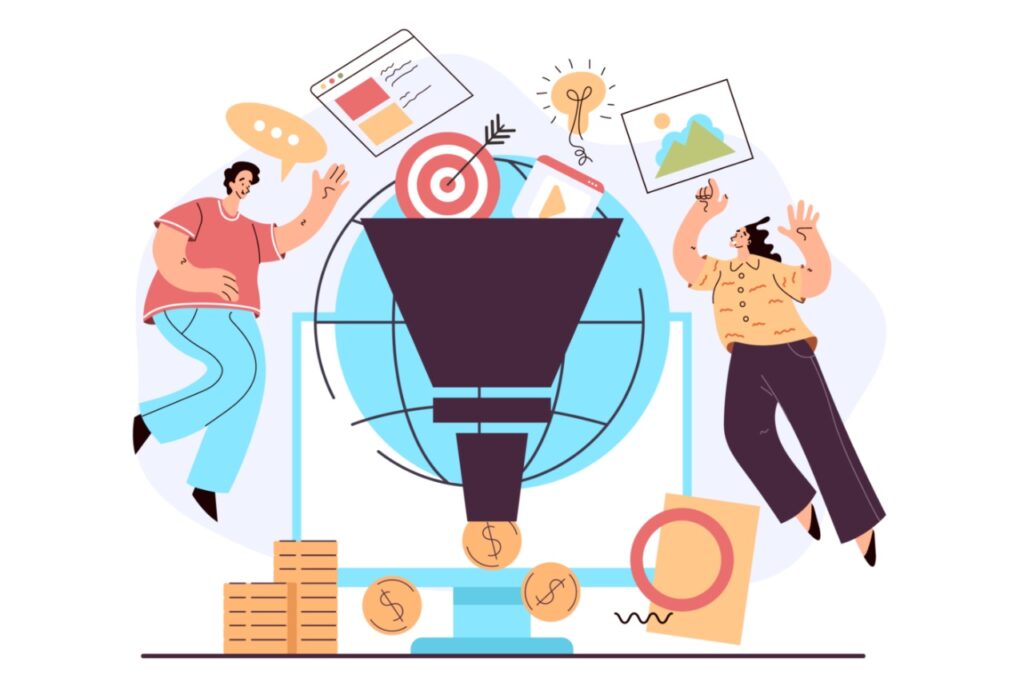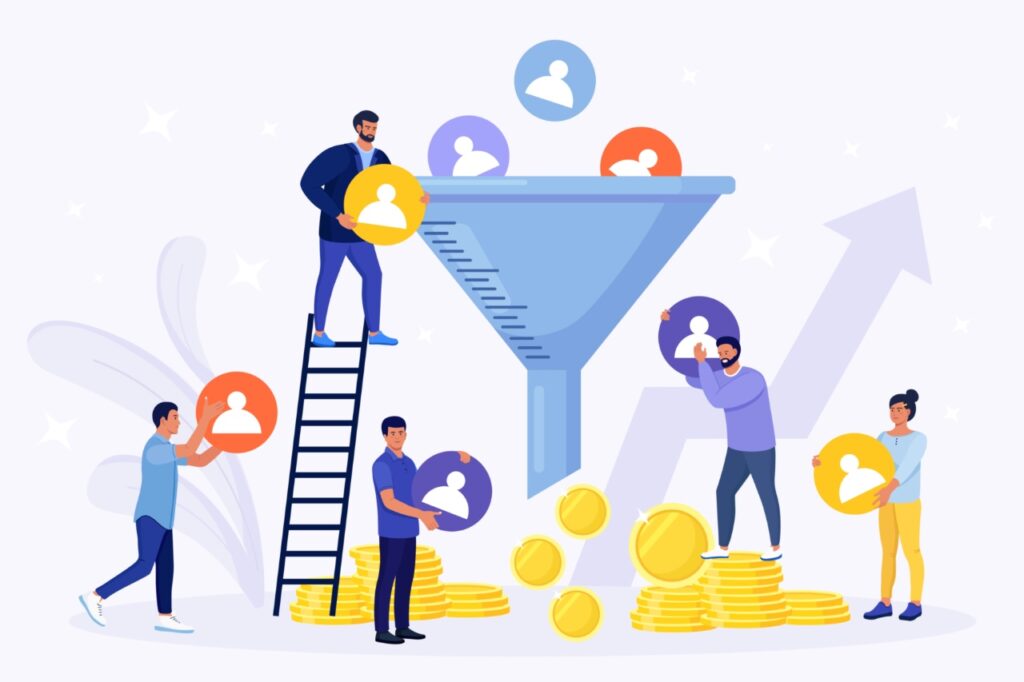Whether you’re a business owner looking to build your brand, or a marketer trying to maximize the return on investment (ROI) of your client’s campaigns, chances are you’re constantly building and deploying new digital marketing strategies. From search engine optimization (SEO) and influencer marketing to pay-per-click (PPC) advertising – digital marketing encompasses a broad spectrum of techniques. However, a well-defined digital marketing strategy goes a long way to building brand awareness and establishing customer trust. It even drives organic search traffic to your website and reinforces your brand identity on social media platforms. But if you’re unable to convert prospects into paying customers, even the best digital marketing campaigns will fail to deliver a high ROI. So the end goal of every campaign should be to positively impact your company’s bottom line. That’s the reason why business owners and marketers should focus their digital marketing efforts on lead generation. Your marketing campaigns will fail to generate actual conversions in the absence of high-quality leads. So, what is lead generation in digital marketing, and how can you use digital marketing tactics to generate qualified leads for your business? There are various ways to generate leads through digital marketing, from leveraging SEO services and PPC advertising to implementing social media marketing campaigns. This blog will outline a few key digital marketing tactics that come in handy for online lead generation. Let’s get started.
Decoding Lead Generation in Digital Marketing
So, what are leads in digital marketing? Surprisingly, you know most things but never noticed technically. Before we delve deeper into online lead generation, let’s first understand who qualifies as a lead. Simply put, a lead is any person or company that expresses interest in your products/services/brand and shares their contact information in exchange for an offer. The most common examples of leads in digital marketing include:
A visitor of your website who subscribes to your newsletter. A social media user who downloads an e-book from your website. An email subscriber who signs up for a free trial of your product. A social media user who registers for a free webinar on your website.
Therefore, we can define digital lead generation as the process of attracting prospects to your brand and maximizing their interest in your products/services. The end goal of every lead generation strategy is to fill your sales funnel with a plethora of qualified leads. That, in turn, helps skyrocket sales and revenue.
The Importance of Lead Generation
First things first – leads are the driving force behind every successful business. Even if you attract thousands of visitors to your website, you can’t generate any revenue without converting them into leads. In the absence of top-notch leads, you can’t harness the potential of sales reps and customer service executives in your company. Nor can you evaluate the impact of various marketing campaigns on your company’s bottom line.
B2B vs B2C Lead Generation
Both B2B and B2C lead generation focus on attracting prospects and nurturing them. However, the main difference between these techniques lies in the type of prospects they’re targeting. While B2B lead generation focuses on attracting key decision-makers and buyers from other companies, the primary focus of B2C lead generation is individual consumers. The type of lead generation techniques you’ll use depends on whether you’re targeting business buyers or consumers. It’s worth noting here that B2B lead generation is more complex and time-consuming than its B2C counterpart.
Different Types of Leads
Now that you’ve understood the importance of lead generation, you can’t wait to start building your strategy. But you must have a clear understanding of different types of leads before getting started.
Marketing Qualified Leads (MQL)
These are prospects who’ve engaged with your marketing assets, such as blog posts, e-books, case studies, etc. But they aren’t ready to receive a sales call just yet.
Sales Qualified Leads (SQL)
These prospects are at the cusp of converting into customers. They’ve likely filled a form inquiring about your product. Or they might have requested a quote for your service. In either case, they’re only a few steps away from becoming paying customers.
Product Qualified Leads (PQL)
These are prospects who’ve already used your product and have taken actions to express interest in becoming paying customers. The most common example is when someone uses a free version of your product and repeatedly tries to access premium features.
Service Qualified Leads
These prospects are already in touch with your customer service team and have shown interest in becoming paying customers.
Digital Marketing & Lead Generation
Lead generation used to be synonymous with cold calling. You’d purchase leads from a third-party vendor and reach out to them with promotional offers. Then, you’d use phone calls, emails, and SMS to connect with prospects. The main challenge with the aforementioned approach is that none of these contacts is familiar with your company. Nor have they shown any interest in using your products/services. So calling them out of the blue makes it difficult to break the barrier. That’s why new-age marketers and business owners focus on inbound lead generation. Unlike cold calling, you only reach out to those buyers or consumers who’ve explicitly indicated an interest in your offerings. But how do you attract these prospects to your brand? The best way is to use various digital marketing channels, including search engines, email, and social media, to grab and retain their attention. For instance, you could use SEO services to drive relevant search engine users to your website. Thereafter, you could continue to impress them with insightful and well-researched blog posts. In addition, you could use strategic calls-to-action (CTAs) within your content to encourage website visitors to download an e-book. The digital leads you generate through this approach are more likely to convert into paying customers. The key is to give them enough time to learn about your company and explore your products before they’re ready to make a purchase.
Digital Marketing Strategies for Lead Generation
Finally, we are coming on, how to generate leads in digital marketing? First things first – inbound lead generation in digital marketing isn’t as simple as adding a few opt-in forms and CTAs to your website. You must identify the right channels to attract and nurture leads. Also, you need to have a deep understanding of the pain points, challenges, aspirations, and ambitions of your prospects. You must have a clear idea of where they’re placed in the buyer’s journey as well. Are you aware of digital lead generation marketing strategies? Here are a few crucial steps you should follow when you’re developing a digital marketing strategy for lead generation:
Cover the Basics
It’s important to understand that a lead could mean different things to different businesses. For example, while some companies focus on skyrocketing newsletter subscriptions, others want to get more people to sign up for free trials of their products. So, before you start outlining a lead generation strategy, you must identify the type of leads you want to generate. Also, you should have a clear understanding of the actions you wish these digital leads to take. It’ll help you define clear goals and key performance indicators (KPIs) for your lead generation strategy. These KPIs will be useful in measuring the performance of your campaigns. While you’re at it, make sure you conduct thorough audience research to understand the needs, struggles, and preferences of your prospects at each stage of the buyer’s journey.
Choose the Right Channels
With modern digital marketing tactics, it’s possible to generate digital leads through a plethora of channels. For example, you can host product giveaways on Instagram, publish an outstanding e-book on your website, or organize a live webinar on Facebook. The important thing is to identify channels that’ll help you reach out to your target audience. Depending on the type of prospects you want to attract, you can use one or more of the following channels:
Social media platforms, such as Facebook, Instagram, Twitter, and LinkedIn Search engines, such as Google and Bing Virtual events and conferences Email Webinars and podcasts Company website and blog
Use survey forms and social media polls for a better understanding of your target audience’s preferred communication channels. The choice of online lead generation channels will also depend on your end goal. For example, if you want prospects to opt-in for a free consultation or product trial, it’s wiser to reach them using personalized email marketing campaigns. On the other hand, if you want website visitors to book a call with your customer service reps, you’d be better off enticing them with attractive blog posts and case studies about your products.
Publish Impressive Content
You must prioritize content creation regardless of the type of lead you want to generate or the marketing channels you’re using. Engaging, meaningful, and well-written content is instrumental in providing value to your audience. Also, it’s crucial for building credibility and trust. While blog posts are the most obvious choice for content creation, you should focus on creating superior quality lead magnets, such as:
E-books Checklists Whitepapers Case studies Infographics User guides
The key is to make a lead magnet so irresistible that your target audience feels compelled to get their hands on it. It’s just as important to showcase these lead magnets strategically. Make sure you create an eye-catching landing page for each lead magnet, highlighting its benefits and overall takeaways. Use a compelling CTA that motivates your audience to take immediate action. The type of lead magnet you should create depends on your target prospects. For instance, if you want to generate sales-qualified leads, you should focus on case studies and product comparison guides. On the other hand, marketing qualified leads can be easily generated using infographics and e-books. Irrespective of the type of lead magnet you’re building, make sure it includes relevant, engaging, and valuable content. In addition, focus on addressing the pain points and needs of your target prospects.
Introduce Other Lead Magnets
Besides conventional lead magnets, you could also use content upgrades and cliffhangers for lead generation in digital marketing. Similarly, you could let website visitors download PDF versions of long-form blog posts in exchange for their contact information. You can even offer transcripts of podcasts or free access to past webinars as lead magnets. If you’re looking to attract sales-qualified leads, a clever tactic is to use free product demos and trials as lead magnets. Or you could entice prospects to book a free consultation with your team.
Focus on SEO
Even the best lead magnets will fail to attract the right prospects if the corresponding landing pages don’t receive enough organic traffic. That emphasizes the importance of outlining a robust SEO strategy. Identify top-performing keywords that your target audience will likely use in their search queries. Next, optimize the landing page content using these keywords. Avoid black hat SEO tactics, such as keyword stuffing and content scraping. Work on page speed, layout, and navigation to deliver a seamless user experience and skyrocket conversions. If you aren’t familiar with the nuances of SEO, it’s a good idea to work with a digital marketing company that specializes in SEO services.
Leverage Social Media Platforms
Whether you’re targeting B2B or B2C leads, social media marketing is essential for driving traffic to your website and landing pages. Start by identifying the platforms your target audience is most likely to use. For instance, while LinkedIn and Twitter are better suited for B2B lead generation, Instagram works better for B2C. Apart from conventional social media posts, you could also host contests and giveaways to win the attention of your target audience. For example, offer free product samples or trial kits as a reward to generate a buzz about your brand. If you’ve already created a lead magnet and built a landing page, make sure you showcase the landing page URL across all your social media profiles. For instance, you could add the link to your Instagram bio. Or you could create a Facebook post about the lead magnet and pin it to the top of your page. Another useful tactic is to participate in relevant discussions and groups. For example, if you’ve identified target prospects on LinkedIn, you can comment on their posts and grab their attention before pitching your lead magnet. Similarly, you can host live sessions on Facebook, Instagram, and YouTube to connect with your audience directly. Again, it’s a great way to learn more about the challenges they face and their expectations from your brand. You can conclude the session with a compelling offer, such as asking them to download a lead magnet, register for an online workshop, or sign up for a free product trial.
Create PPC Ad Campaigns
While SEO and social media marketing help boost organic traffic, it could take a while before these strategies yield any significant results. So if you want to expedite lead generation in digital marketing, make sure you run PPC campaigns on social media and search engines. You can use Google Ads to promote a particular landing page in relevant Google search results. Make sure you choose the right keywords for each campaign. If you’re looking to generate traction on social media, you can use Facebook and Instagram ads to reach more prospects. In addition, Facebook and LinkedIn simplify lead generation even further by letting you integrate contact forms into your ad campaigns.
Don’t Ignore Email Marketing
SEO, PPC advertising, and social media marketing are great ways to generate marketing-qualified leads. But if you want these leads to move further along in the sales funnel, you must nurture and engage with them using powerful email marketing campaigns. It’s worth noting that email marketing isn’t the same as sending daily or weekly newsletters. Of course, newsletters help fuel a prospect’s interest in your brand. But if you want to convert them into sale-qualified and product-qualified leads, you must implement personalized campaigns that cater to a prospect’s individual needs and challenges. The good thing is that modern email marketing platforms offer a wide array of tools and insights to help you personalize your campaigns. For instance, you can tailor your emails based on how subscribers interact with your previous newsletters. Or you can send targeted emails to visitors who take specific actions on your website. The key is to provide them with all the necessary information they need before they’re ready to make a purchase decision.
Integrate Marketing, Sales, and Customer Service
Lead generation in digital marketing isn’t solely about collecting a prospect’s contact information. If you want to maximize the ROI of your campaigns, you must ensure that these leads convert into loyal customers. That, in turn, emphasizes the importance of flawless coordination and collaboration between marketers and customer-facing professionals, such as sales and customer service reps. Make sure these departments provide continuous feedback to each other.
Measure and Improve
As with any digital marketing campaign, you must monitor the performance of your lead generation strategy, measure various KPIs, and identify ways to enhance its performance. Collect analytics from your website, social media profiles, and email marketing platforms to understand how your prospects respond to various lead magnets.
Final Takeaways
The days of using cold calling and mass emails for lead generation are long gone. Instead, you must harness various digital marketing techniques if you want to generate qualified leads for your business in 2022. Publish great content in the form of lead magnets, such as case studies, reports, and infographics. Promote your lead magnets using various communication channels, including social media, search engines, and email. Lastly, don’t forget to monitor, measure, and optimize the performance of your campaigns.


